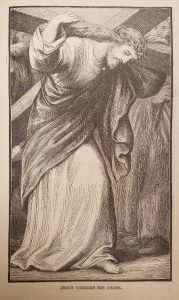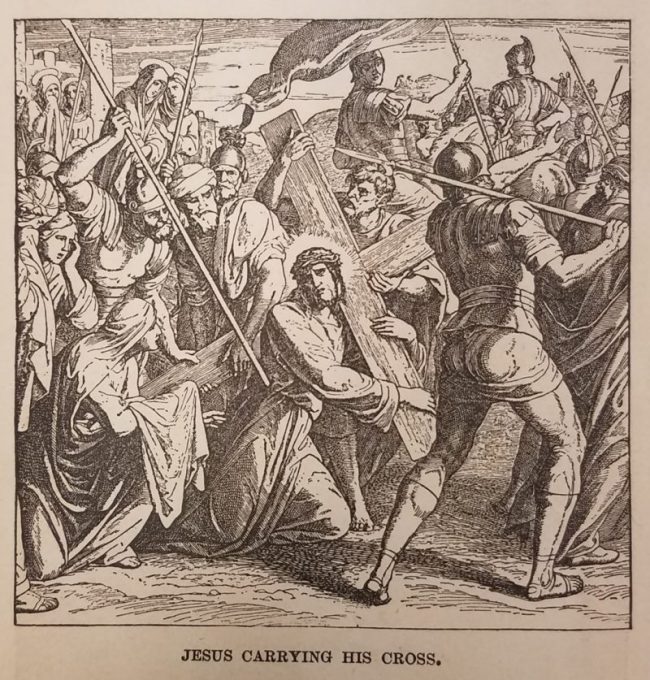Image from: Josephine Pollard
The Bible and Its Story
New York: Ward and Drummond, 1889
LENTEN REFLECTIONS
“My Jesus, I accept all the crosses, all the contradictions, all the adversities that the Father has destined for me. May the unction of Thine grace give me strength to bear these crosses with the submission of which Thou gavest us the example in receiving Thine for us. May I never seek my glory save in the sharing of Thine sufferings!”[1]
Lent is a period of fasting, prayer and giving. At this time, we remember the importance of opening our hearts to God’s love and one another. This year, during the Covid-19 pandemic, it is especially important to care for those who are suffering or to reassure those who are fearful.[2] These practices improve our spiritual well-being. By stripping away what is unnecessary, we become more mindful of how God is working in our lives.[3] Against this backdrop of spiritual reflection and acts of care, the natural cycles of life continue, and winter slowly yields to spring. Days are getting longer, songbirds are returning and the trees are showing the first signs of budding. Nature shows us there is promise and hope amidst the pain. Similarly, Lent invites us into a 40-day journey of renewed faith, hope, love, discovery and recovery on the worldly and spiritual planes.[4]
The cross is perhaps the most powerful and recognizable symbol of Christianity, especially during the Easter season for its significance  with Jesus’ crucifixion. For Christians, the cross symbolizes Christ’s victory over sin and death and God’s love.[5] The engraved images in this post are taken from a rare book in the university’s Department of Archives and Special Collections. Published in 1889 and authored by Josephine Pollard, “The Bible and Its Story” contains many detailed illustrations including these of Jesus bearing the cross.
with Jesus’ crucifixion. For Christians, the cross symbolizes Christ’s victory over sin and death and God’s love.[5] The engraved images in this post are taken from a rare book in the university’s Department of Archives and Special Collections. Published in 1889 and authored by Josephine Pollard, “The Bible and Its Story” contains many detailed illustrations including these of Jesus bearing the cross.
Pollard was an American author, hymn writer and poet. She was born in New York City in 1834 and was educated at the Spingler Institute for Girls in New York[6]. The school was founded by Gorham Dummer Abbott, an American clergyman, educator, and author who seemingly had a profound impact on her life.[7] Both Pollard and Abbott were dedicated to education, as well as their shared Christian faith and writing. Abbott also influenced Matthew Vassar, founder of the eponymously named college which was the second degree-granting institution of higher education for women in the United States.[8]
Pollard was a founding member of Sorosis, a professional organization of women founded “to promote ‘mental activity and pleasant social intercourse,’ and in spite of a severe fire of hostile criticism and misrepresentation, it has evinced a sturdy vitality, and really demonstrated its right to exist by a large amount of beneficent work. … These ladies pledged themselves to work for the release of women from the disabilities which debar them from a due participation in the rewards of industrial and professional labour … I believe it has been the stepping-stone to useful public careers, and the source of inspiration to many ladies.”[9]

Early members of Sorosis were participants in varied professions and political reform movements such as abolitionism, suffrage, prison reform, temperance and peace. The organization expanded into local chapters beyond New York City in the early twentieth century and the various divisions went on to organize war relief efforts during both World Wars. Peacetime activities included philanthropy (such as support for funding the MacDowell Colony), scholarship funds, and social reforms (such as literary training for immigrant women). In later years, Sorosis focused its activities on local projects, raising money for the aid of other women’s clubs, funding scholarships for women, and aiding local rescue missions.
 Though she died at the age of 57, the trailblazing Josephine Pollard left behind an extensive legacy of books, hymns and poems, as well as a history of activism that reverberates today through educational and professional opportunities for students and women in the form of scholarships and residencies. Pollard’s hymns remain popular as well and continue to inspire congregants. One of Pollard’s best-known hymns is “I Stood Outside the Gate.” Intended for the Lenten season, its words remind us of Jesus’ mercy and his sacrifice for humanity:
Though she died at the age of 57, the trailblazing Josephine Pollard left behind an extensive legacy of books, hymns and poems, as well as a history of activism that reverberates today through educational and professional opportunities for students and women in the form of scholarships and residencies. Pollard’s hymns remain popular as well and continue to inspire congregants. One of Pollard’s best-known hymns is “I Stood Outside the Gate.” Intended for the Lenten season, its words remind us of Jesus’ mercy and his sacrifice for humanity:
“In Mercy’s guise I knew
The Savior long abused,
Who often sought my heart,
And wept when I refused;
Oh, what a blest return
For all my years of sin!
I stood outside the gate,
And Jesus let me in.”[10]
The images and materials shown here are but a small part of the vast patrimony available to students, faculty and researchers. For access to this or other objects in our collections, complete a research request form to set up an appointment or contact us at 973-761-9476.
[1] Marmion, Dom Columba. Christ in His Mysteries: A Spiritual Guide Through the Liturgical Year. Leominster: Gracewing Publishing, 2016.
[2] https://catholicphilly.com/2021/02/lent2021/pope-francis-lenten-message-a-time-to-renew-faith-hope-love/, accessed 2/24/2021.
[3] https://bustedhalo.com/ministry-resources/25-great-things-you-can-do-for-lent, accessed 2/24/2021.
[4] https://www.ncronline.org/news/opinion/young-voices/season-renewal-recovery-discovery, accessed 2/25/2021.
[5] https://omaha.com/special_sections/from-lilies-to-lambs-easter-symbols-hold-special-significance-for-christians/article_fe75f253-6966-55c7-958053acdd014f89.html#:~:text=The%20cross%20is%20perhaps%20the,humiliation%20in%20the%20Roman%20Empire, accessed 2/25/2021.
[6] https://en.wikipedia.org/wiki/Josephine_Pollard, accessed 2/25/2021.
[7] https://en.wikipedia.org/wiki/Gorham_Dummer_Abbott#Biography, accessed 2/25/2021.
[8] https://www.vassar.edu/about/, accessed 2/25/2021.
[9] Faithfull, Emily (1884). Three Visits to America. New York: Fowler & Wells Co., Publishers. pp. 18–21.
[10] https://hymnary.org/text/i_stood_outside_the_gate, accessed 2/25/2021.
